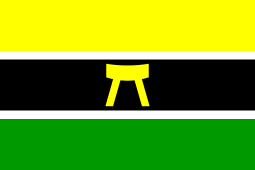Anglo-Ashanti wars
| Anglo-Ashanti wars | |||||||
|---|---|---|---|---|---|---|---|
| Part of the Scramble for Africa | |||||||
| |||||||
| Belligerents | |||||||
| British-allied African states |
| ||||||
| Commanders and leaders | |||||||
|
|
Osei Bonsu Osei Yaw Akoto Kwaku Dua I Panyin Kofi Karikari Mensa Bonsu Kwaku Dua II Prempeh I (POW) | ||||||
| Strength | |||||||
|
|
20,000 (1st) | ||||||
| Casualties and losses | |||||||
|
|
over 2,000 (1st) unknown (3rd) 0 (4th) | ||||||
The Anglo-Ashanti Wars were a series of five conflicts between the Ashanti Empire, in the Akan interior of the Gold Coast (now Ghana), and the British Empire and British-allied African states that took place between 1824 and 1901. The wars were mainly due to Ashanti attempts to establish strong control over the coastal areas of what is now Ghana. Coastal peoples, such as the Fante and the inhabitants of Accra, who were chiefly Ga, came to rely on British protection against Ashanti incursions.
Earlier wars
The British were drawn into three earlier wars in the Gold Coast:
In the Ashanti-Fante War of 1806–07, the British refused to hand over two rebels pursued by the Ashanti, but eventually handed one over (the other escaped).
In the Ga-Fante War of 1811, the Akwapim captured a British fort at Tantamkweri and a Dutch fort at Apam.
In the Ashanti-Akim-Akwapim War of 1814–16 the Ashanti defeated the Akim-Akwapim alliance. Local British, Dutch, and Danish authorities all had to come to terms with the Ashanti. By 1817, the Ashanti, who had an army of 20,000, had become the strongest power in West Africa,[1] so the (British) African Company of Merchants signed a treaty of friendship that recognized Ashanti claims to sovereignty over much of the coast. The African Company of Merchants was dissolved in 1821 and the British assumed control of the Gold Coast.[1]
First Anglo-Ashanti War (1823-1831)
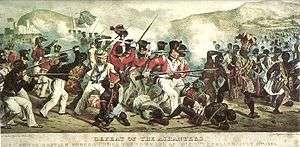
By the 1820s the British had decided to support one of the other tribes, the Fante, enemies of the Ashanti. Inland, the Ashanti kings who ruled from the Golden Stool – said to have come from their great god guardian of the Ashanti soul, "Nyame" – would not allow themselves to be governed by the British.[2] Economic and social friction played their part in the causes for the outbreak of violence.[1]
The immediate cause of the war happened when a group of Ashanti kidnapped and murdered an African sergeant of the Royal African Corps.[3] A small British group was led into a trap which resulted in 10 killed, 39 wounded and a British retreat. The Ashanti tried to negotiate but the British governor, Sir Charles MacCarthy, rejected Ashanti claims to Fanti areas of the coast and resisted overtures by the Ashanti to negotiate. This started the First Anglo-Ashanti War which ran until 1831.
MacCarthy led an invading force from the Cape Coast in two columns: the governor was in the first group of 500, out of touch with the second column of 2,500 when he encountered an Ashanti army of around 10,000 on 22 January 1824, in the Battle of Nsamankow. The British were overrun, suffered losses, and ran out of ammunition. Almost all the British force were killed immediately; only around 20 managed to escape. MacCarthy, along with the ensign and his secretary, attempted to fall back; he was wounded by gunfire, however, and killed by a second shot shortly thereafter. Ensign Wetherell was killed while trying to defend MacCarthy's body and Williams taken prisoner. On his return, he related that he had only survived through being recognised by an Ashanti chief for whom he had done a small favour, and was spared; he was held prisoner for several months, locked in a hut which he shared with the severed heads of MacCarthy and Wetherell, kept as trophies of war for years. McCarthy's gold-rimmed skull was later used as a drinking-cup by the Ashanti rulers. Eye-witness accounts of Sir MacCarthy's death stated "He saw ensign Wetherell, who appeared also to have been wounded, lying close to Sir Charles, Some of the Ashantis were attempting to cut off his head, and had already inflicted one gash on the back of his neck; luckily at this crisis an Ashanti of authority came up and recognising Mr Williams, from whom he had received some kindness, withheld the hand of the assailant. On Mr Williams's recovering his senses, he saw the headless trunks of Sir Charles McCarthy, Mr Buckle, and Ensign Wetherell. During his captivity he was lodged under a thatched shed in the same rooms as the heads which, owing to some peculiar process, were in a perfect state of preservation".[2] Major Alexander Gordon Laing returned to Britain with news of their fate. The Ashanti swept down to the coast, but disease forced them back.
The new governor of the Gold Coast, John Hope Smith, started to gather a new army, mainly comprising natives, including Denkyiras, many of the traditional enemies of the Ashanti. In August 1826 the governor heard that the Ashanti were planning on attacking Accra. A defensive position was prepared on the open plain 10 miles (16 km) north of Accra and the 11,000 men waited.[4] On 7 August the Ashanti army appeared and attacked the centre of the British line where the best troops were held, which included some Royal Marines, the militia and a battery of Congreve rockets. The battle dissolved into hand-to-hand fighting but the Ashanti force were not doing well on their flanks whilst they looked like winning in the centre. Then the rockets were fired.[1] The novelty of the weapons, the explosions, rocket trails, and grievous wounds caused by flying metal shards caused the Ashanti to fall back. Soon they fled leaving thousands of casualties on the field.[5]
The war was effectively over. In 1831, the Pra River was accepted as the border in a treaty, and there was thirty years of peace.
Second Anglo-Ashanti War
In late 1823, following the disagreements between the Fantis and the Ashantis, MacCarthy declared war on the king of the Ashanti; after organising the defences of Cape Coast, he set out with an expedition of some 80 men of the Royal African Colonial Corps, 170 men of the Cape Coast Militia, and 240 Fanti tribesmen under their local chiefs. He was accompanied by a captain and an ensign of the 2nd West India Regiment, as aides-de-camp, a surgeon of the same regiment, and J. T. Williams, his colonial secretary. This was not the only part of his force; three other groups of infantry were in the region, one of 600 regulars of the RACC and 3,000 native levies, one of 100 regulars and militia and 2,000 levies (under Major Alexander Gordon Laing), and a third of 300 regulars and militia and 6,000 levies. The plan was for the four groups to converge and then engage the enemy with overwhelming force.
On the night of the 20th, still without having joined forces with the other three groups, his force camped by a tributary of the Pra River. The next day, at around 2pm, they encountered a large enemy force of around ten thousand men; in the belief that the Ashanti army contained several disaffected groups whose chiefs were willing to defect, MacCarthy instructed the band to play the National Anthem loudly. The Ashanti responded by approaching closer, beating war drums, and his beliefs were swiftly dispelled.
Fighting started shortly thereafter; the two sides were separated by a 60-foot-wide (18 m) stream, which the Ashanti made no major attempt to ford, both sides contenting themselves with staying firm and keeping up a continual musket fire. However, the British forces were lightly supplied; the bearers bringing the supplies up in the rear, which included most of the gunpowder and ammunition, mostly fled after hearing the firing in the distance and encountering deserters straggling back. Only one additional barrel of powder and one of shot were brought up, and ammunition ran out around 4pm; the Ashanti then made a determined attempt to cross the river, and quickly broke into the camp.
Almost all the British force were killed immediately; only around 20 managed to escape. MacCarthy, along with the ensign and his secretary, attempted to fall back; he was wounded by gunfire, however, and killed by a second shot shortly thereafter. Ensign Wetherell was killed whilst trying to defend MacCarthy's body and Williams taken prisoner. On his return, he related that he had only survived through being recognised by an Ashanti chief for whom he had done a small favour, and was spared; he was held prisoner for several months, locked in a hut which he shared with the severed heads of MacCarthy and Wetherell, kept as trophies of war. McCarthy's gold-rimmed skull was later used as a drinking-cup by the Ashanti rulers. MacCarthy was succeeded as governor by Charles Turner.
The Real Second Anglo-Ashanti War (1863 1864)
With the exception of a few minor Asante skirmishes across the Pra in 1853 and 1854, the peace between Asanteman and the British had remained unbroken for over 30 years.
The second Anglo-Ashanti War occurred between 1863 and 1864. In 1863, a large Ashanti force crossed the Pra River in search of a fugitive, Kwesi Gyana.
There was fighting, with casualties on both sides, but the governor's request for troops from England was declined and sickness forced the withdrawal of his West Indian troops, with both sides losing more men to sickness than any other factor, and in 1864 the war ended in a stalemate.
Third Anglo-Ashanti War
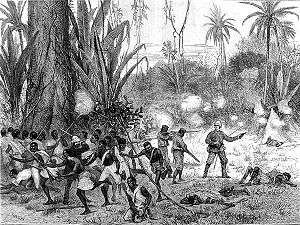
The Third Anglo-Ashanti War, also known as the "First Ashanti Expedition", lasted from 1873 to 1874. In 1869, a German missionary family and a Swiss missionary had been taken from Togo to Kumasi. They were still being held in 1873.[6]
The British Gold Coast was formally established in 1867 and in 1872, Britain expanded their territory when they purchased the Dutch Gold Coast from the Dutch, including Elmina which was claimed by the Ashanti. The Dutch had signed the Treaty of Butre in 1656 with the Ahanta. The treaty's arrangements proved very stable and regulated Dutch-Ahanta diplomatic affairs for more than 213 years. This all changed with the sale of the Dutch Gold Coast. The Ashanti invaded the new British protectorate.
General Garnet Wolseley was sent against the Ashanti with 2,500 British troops and several thousand West Indian and African troops (including some Fante) and subsequently became a household name in Britain. The war was covered by war correspondents, including Henry Morton Stanley and G. A. Henty. Military and medical instructions were printed for the troops.[7] The British government refused appeals to interfere with British arms manufacturers who sold to both sides.[8]
- Road building
Wolseley was appointed on 13 August 1873[1] and went to the Gold Coast to make his plans before the arrival of his troops in January 1874. On 27 September 1873 a team of Royal Engineers landed at Cape Coast Castle. Their job was to expand the single file track that led to Coomassie, 160 miles (260 km) away, into a road that was suitable for troop movements. At the end of each day's march, roughly every 10 miles (16 km) a fortified camp would be built with 70 feet (21 m) long huts inside a stockade in an area that had been cleared of trees and undergrowth to provide some protection against hostile natives.[9]
Bridges were built across streams using trees, bamboo and creepers for ropes and a major bridge across the 63 yards (58 m)-wide River Prah was built using pre-manufactured pieces brought from Chatham, England. In total 237 bridges would be built. Some of the camps were larger -- Prahsue, next to the bridge had a medical hut and a tower on a mound, stores, forge, telegraph office and post office.[10] It was stocked with 400 tons of food and 1.1m rounds of ammunition.[11] The labour was supplied locally. To start the workers did not know how to use European tools and were liable to vanish into the forest if they heard a rumour that the Ashanti were nearby. Sickness, despite taking quinine daily, claimed the European engineers. Even so, the road progressed. By 24 January a telegraph line reached Prahsue.[12]
The first troops arrived in late December and on 1 January 1874 started marching along the road to the front, half a battalion at a time.[13] The troops comprised a battalion each from the Black Watch, Rifle Brigade and Royal Welsh Fusiliers, along with the 1st and 2nd West India Regiments, a Naval Brigade, two native regiments, Royal Artillery, Royal Engineers and Royal Marines.[14] By 29 January, the road was more than half completed and they were close to Ashanti outposts. Skirmishing between the two forces began. Wolseley prepared to fight a battle.[15]
- Battle
The Battle of Amoaful was fought on 31 January. A road was cut to the village and the Black Watch led the way, forming square in the clearing with the Rifle Brigade, while flanking columns moved around the village. With the pipes playing "The Campbells Are Coming" the Black Watch charged with bayonets and the shocked Ashantis fled. The flank columns were slow moving in the jungle and the Ashantis moved around them in their normal horseshoe formation and attacked the camp 2 miles (3.2 km) to the rear. The Royal Engineers defended themselves until relieved by the Rifle Brigade. Although there was another small battle two days later, the Battle of Ordashu, the action had been decisive and the route to Kumasi was open.[16] There were three killed and 165 wounded Europeans, one killed and 29 African troops wounded.[17]
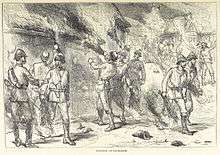
The capital, Kumasi, was abandoned by the Ashanti when the British arrived on 4 February and was briefly occupied by the British. They demolished the royal palace with explosives, leaving Kumasi a heap of smouldering ruins.[17] The British were impressed by the size of the palace and the scope of its contents, including "rows of books in many languages."[18]
The Asantahene, the ruler of the Ashanti, signed the harsh Treaty of Fomena in July 1874 to end the war. Among articles of the treaty between H.M. Queen Victoria, Queen of Great Britain and Ireland and H.M. Kofi Karikari, King of Ashanti were that "The King of Ashanti promises to pay the sum of 50,000 ounces of approved gold as indemnity for the expenses he has occasioned to Her Majesty the Queen of England by the late war..." The treaty also required an end to human sacrifice[6] and stated that "There shall be freedom of trade between Ashanti and Her Majesty's forts on the [Gold] Coast, all persons being at liberty to carry their merchandise from the Coast to Kumasi, or from that place to any of Her Majesty's possessions on the Coast." Furthermore, the treaty stated that "The King of Ashanti guarantees that the road from Kumasi to the River Pra shall always be kept open..."[19] Wolseley completed the campaign in two months, and re-embarked for home before the unhealthy season began.
Wolseley was promoted and showered with honours. British casualties were 18 dead from combat and 55 from disease (70%[6]), with 185 wounded.[17]
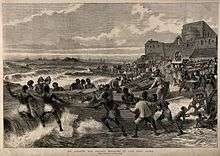
Some British accounts pay tribute to the hard fighting of the Ashanti at Amoaful, particularly the tactical insight of their commander, Amankwatia: "The great Chief Amankwatia was among the killed [...] Admirable skill was shown in the position selected by Amankwatia, and the determination and generalship he displayed in the defence fully bore out his great reputation as an able tactician and gallant soldier."[20]
The campaign is also notable for the first recorded instance of a traction engine being employed on active service. Steam sapper number 8 (made by Aveling and Porter) was shipped out and assembled at Cape Coast Castle. As a traction engine it had limited success hauling heavy loads up the beach, but gave good service when employed as a stationary engine driving a large circular saw.[21]
Before the 1873 war, Wolseley had campaigned for a more comfortable clothing for hot climates and in this war had managed to get his troops kitted out in a better uniform.[22]
Fourth Anglo-Ashanti War
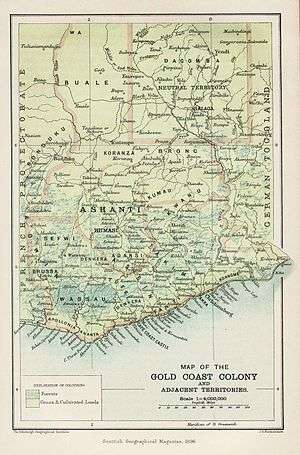
The Fourth Anglo-Ashanti War, also known as the "Second Ashanti Expedition", was brief, lasting only from December 1895 to February 1896. The Ashanti turned down an unofficial offer to become a British protectorate in 1891, extending to 1894. The British also wanted to establish a British resident in Kumasi. The Ashanti King Prempeh refused to surrender his sovereignty.[23] Wanting to keep French and German forces out of Ashanti territory (and its gold), the British were anxious to conquer the Ashanti once and for all. The Ashanti sent a delegation to London offering concessions on its gold, cocoa and rubber trade as well as submission to the crown. The British however had already made its mind up on a military solution,[1] they were on their way, the delegation only returning to Kumasi a few days before the troops marched in.[24]
Colonel Sir Francis Scott left Cape Coast with the main expeditionary force of British and West Indian troops, Maxim guns and 75mm artillery in December 1895, and travelling along the remnants of the 1874 road arrived in Kumasi in January 1896.[1] Major Robert Baden-Powell led a native levy of several local tribes in the campaign. The Asantehene directed the Ashanti not to resist, but casualties from sickness among the British troops were high.[25] Soon, Governor William Maxwell arrived in Kumasi as well. Asantehene Agyeman Prempeh was unable or unwilling to pay the 50,000 ounces of gold so was arrested and deposed.[1] He was forced to sign a treaty of protection, and with other Ashanti leaders was sent into exile in the Seychelles.
Baden-Powell published a diary of life giving the reasons, as he saw them, for the war: To put an end to human sacrifice. To put a stop to slave-trading and raiding. To ensure peace and security for the neighbouring tribes. To settle the country and protect the development of trade. To get paid up the balance of the war indemnity. He also believed that if a smaller force had been sent, there would have been bloodshed.[24]
The British force left Kumasi on 22 January 1896, arriving back at the coast two weeks later. Not a shot had been fired but 18 Europeans were dead and 50% of the troops were sick. Among the dead was Queen Victoria's son-in-law, Prince Henry of Battenberg,[1] who was taken ill before getting to Kumashi and died on 20 January onboard ship, returning to England. In 1897 Ashanti territory became a British protectorate.[1]
Fifth War or "War of the Golden Stool"
Technology was reaching the Gold Coast, a railway to Kumasi was started in 1898 but had not progressed far when another war broke out. The railway was to be completed in 1903.[26]
In the War of the Golden Stool (1900), also known as the "Third Ashanti Expedition", on 25 March 1900, the British representative, Sir Frederick Mitchell Hodgson committed a political error by insisting he should sit on the Golden Stool, not understanding that it was the Royal throne and very sacred to the Ashanti.[27] He ordered a search be made for it. The Ashanti, enraged by this act, attacked the soldiers engaged in the search.
The British retreated to a small stockade, 50 yards (46 m) square with 12 feet (3.7 m) loopholed high stone walls and firing turrets at each corner,[28] where 8 Europeans, dozens of mixed-race colonial administrators, and 500 Nigerian Hausas with six small field guns and four Maxim guns defended themselves. The British detained several high-ranking leaders in the fort.[28] The stockade was besieged and the telegraph wires cut. A rescue party of 700 arrived in June, but many sick men in the fort could not be evacuated. The healthier men escaped, including Hodgson and his wife and 100 Hausas, and meeting up with the rescue party, managed to avoid the 12,000 Ashanti warriors and make it back to the coast.[28]
On 14 July a second relief force of 1,000 made it to Kumasi having fought several engagements along the route, relieving the fort on 15 July when they only had a few days of supplies left. The remaining Ashanti court not exiled to the Seychelles had mounted the offensive against the British and Fanti troops resident at the Kumasi Fort, but were defeated.
Yaa Asantewaa, the Queen-Mother of Ejisu, who had led the rebellion, King Prempeh I, and other Ashanti leaders were also sent to the Seychelles. The Ashanti territories became part of the Gold Coast colony on 1 January 1902, on the condition that the Golden Stool would not be violated by British or other non-Akan foreigners. The Ashanti claimed a victory as they had not lost their sacred stool. In September the British sent flying columns out to visit neighbouring peoples who had supported the rebellion, resulting in a number of skirmishes.
The British and their allies suffered 1,007 fatalities in total. The Ashanti casualties are estimated to have been around 2,000. The sacred golden stool, which is depicted on the Ashanti flag, had been well hidden and was only discovered by road workers by accident in 1920. King Prempeh I returned from exile in 1924, travelling to Kumasi by a special train.
Awards
Four awards were made of the Victoria Cross, for Gallantry in the period 1873-74 and two for the 1900 campaign. (see List of Victoria Cross recipients by campaign)
An Ashanti Medal was created for those involved in the War of the Golden Stool. This expedition lasted from March – September 1900. It was issued as a Silver or bronze Medal.
Further reading
- Agbodeka, Francis (1971). African Politics and British Policy in the Gold Coast, 1868–1900: A Study in the Forms and Force of Protest. Evanston, IL: Northwestern University Press. ISBN 0-8101-0368-0.
- McCarthy, Mary (1983). Social Change and the Growth of British Power in the Gold Coast: The Fante States, 1807–1874. Lanham, MD: University Press of America. ISBN 0-8191-3148-2.
- Wilks, Ivor (1975). Asante in the Nineteenth Century: The Structure and Evolution of a Political Order. London: Cambridge University Press. ISBN 0-521-20463-1.
- Adu Boahen, A. Yaa Asantewaa and the Asante-british War of 1900-1. ISBN 978-9988550998.
See also
References
- 1 2 3 4 5 6 7 8 9 10 Raugh (2004)
- 1 2 "BBC - Radio 4 Empire - West Africa - Jaw-jaw". www.bbc.co.uk. Retrieved 2017-02-11.
- ↑ Freeman (1898), pp. 462-463
- ↑ Raugh (2004), p. 34
- ↑ Lloyd (1964), pp. 39–53
- 1 2 3 Goldstein (2005)
- ↑ Lloyd (1964), pp. 88–102
- ↑ Lloyd (1964), p. 83
- ↑ Porter (1889), p. 11
- ↑ Porter (1889), p. 13
- ↑ Raugh (2004), p. 36
- ↑ Porter (1889), pp. 14–17
- ↑ Porter (1889), p. 17
- ↑ Raugh (2004), p. 15
- ↑ Porter (1889), p. 19
- ↑ Raugh (2004), p. 16
- 1 2 3 Raugh (2004), p. 37
- ↑ Lloyd (1964), pp. 172–174, 175
- ↑ Anonymous (1874)
- ↑ Low (1878), p. 174
- ↑ Nowers (1994), pp. 10–11
- ↑ Kochanski (1999)
- ↑ Raugh (2004), p. 30
- 1 2 "THE DOWNFALL OF PREMPEH A DIARY OF LIFE WITH THE NATIVE LEVY IN ASHANTI 1895-96". pinetreeweb.com.
- ↑ Lloyd (1964), pp. 162–176
- ↑ "A Railway Through the African Jungle". mikes.railhistory.
- ↑ "Asante". BBC worldservice.
- 1 2 3 Edgerton (2010)
Bibliography
- Anonymous (11 June 1874). "The Treaty with the King of the Ashantees". Wanganui Herald. VIII (2195). p. 2.
- Edgerton, Robert B. (2010). The Fall of the Asante Empire: The Hundred-Year War For Africa's Gold Coast. ISBN 9781451603736.
- Freeman, Richard Austin (1898). Travels and Life in Ashanti and Jaman. A. Constable & Company.
- Goldstein, Erik (2005). Wars and Peace Treaties: 1816–1991. London: Routledge. ISBN 9781134899111.
- Kochanski, Halik (1999). Sir Garnet Wolseley: Victorian Hero. ISBN 9781852851880.
- Lloyd, Alan (1964). The Drums of Kumasi: the story of the Ashanti wars. London: Longmans. LCCN 65006132. OL 5937815M.
- Low, Charles Rathbone (1878). A Memoir of Lieutenant-General Sir Garnet J. Wolseley. London: R. Bentley & Son.
- Nowers, Colonel John (1994), Steam Traction in the Royal Engineers, North Kent Books, ISBN 0-948305-07-X
- Porter, Maj Gen Whitworth (1889). History of the Corps of Royal Engineers. II. Chatham: The Institution of Royal Engineers.
- Raugh, Harold E. (2004). The Victorians at War, 1815–1914: an Encyclopedia of British Military History. ABC-CLIO. ISBN 9781576079256.
External links
- Jim Jones (2004). "The British in West Africa". Archived from the original on 7 November 2009. Retrieved 2009-11-07.
- Stanley, Henry Morton (1876). Coomassie and Magdala: the story of two British campaigns in Africa. New York: Harper.
- Boyle, Frederick (1874). Through Fanteeland to Coomassie, a diary of the Ashantee expedition. London: Chapman and Hall.
- Reade, Winwood (1874). The Story of the Ashantee Campaign. London: Smith, Elder & Co.
- Henty, George A (1904). Through Three Campaigns A Story of Chitral, Tirah and Ashanti. – historical fiction
